For some time, finding a left-sided, left-footed central defender (LCB) has been difficult for many EFL managers.
The issue is that few players match that description compared to right-sided, right-footed central defenders.
This means the demand for LCBs is higher, and clubs can set a higher price for established players.
With that said, in the EFL Championship, League One, and League Two, there are several left-footed LCBs – the question is, how good are they?
The role of a left-footed central defender is important as it can provide an element of balance to tactical proceedings when playing out from the back, for example.
In this data analysis, we will compare the data of 55 central defenders in the three divisions mentioned above to see which excels both defensively and in possession.
Scouting Criteria
For this analysis, we initially launched a search on Wyscout for left-footed central defenders (playing either CB in a back three/five or LCB in any formation) – the top 20 defenders matching that description from each EFL league, with that 20 being picked by minutes played in the last year.
Five of the 60 players were removed from the list as they no longer play in the EFL—of course, Wyscout generated the list of players based on the last 12 months, so this was always a possibility.
All players involved are currently playing for EFL clubs this season, but since the data goes back to last season, it is possible that we have players who played outside of the EFL during the 23/24 season but are active this season.
There is one exception: players who played in the EFL last season and have gone on to play in the Premier League this season have been included.
We only selected defenders who primarily play CB/LCB.
Wyscout gave us some defenders who have played that position but who are primarily left-back/left wing-backs (LB/LWB); these players were not included in our final shortlist for the analysis.
To that point, it is essential to note that some players may have played more minutes in the 24/25 season at LB/LWB, but over the past 12 months, they have played mainly as LCB/CB.
The statistics included in this data analysis date back to the start of the 23/24 campaign, effectively giving us over 50 matches worth of data to work with.
Defensive Talent
Ultimately, the bedrock of any defender worth their salt is their defensive ability.
An imposing central defender must be able to engage in duels and be consistently effective, both in the air and on the ground.
This data analysis segment will explore the defensive statistics of the selected defenders.
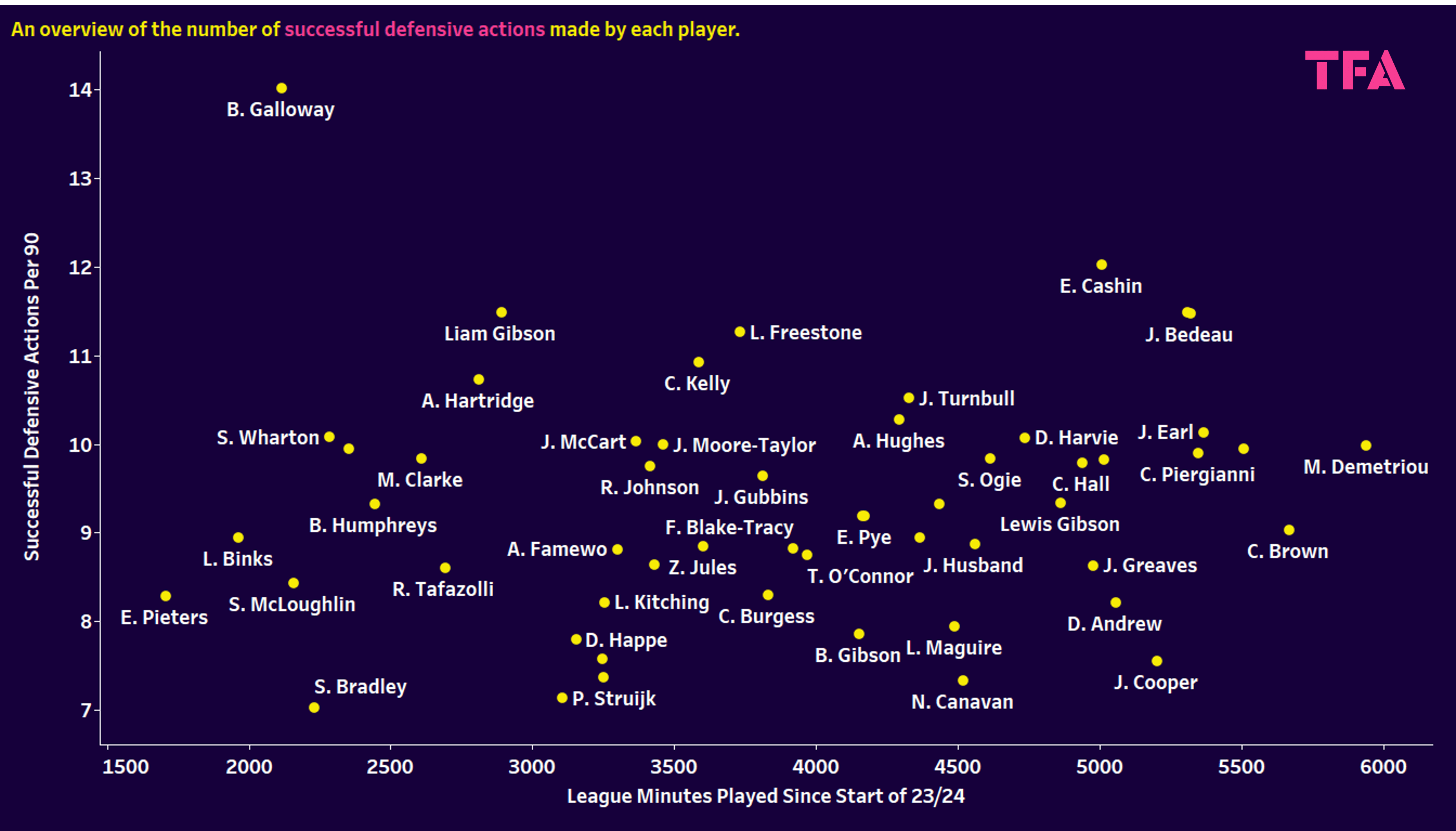
We summarise the 55 defenders’ defensive contributions in this data analysis.
We look at their successful defensive actions per 90 minutes and the number of minutes they’ve featured since the start of the 23/24 league campaign.
We felt the need to include the league minutes to add context to the time span in which these defensive contributions were made.
For example, Plymouth Argyle defender Brendan Galloway has an exceptional number of successful defensive actions per 90 (14.02) but has only played 2118 league minutes since the start of last season.
That doesn’t mean he is any less effective when playing; that number of defensive contributions is very impressive, but we’re looking for players who succeed over a larger amount of game time.
Eiran Cashin of Derby County fits the bill, playing 5008 minutes in the given period and averaging 12.02 successful defensive actions per 90 – a sign of consistent, effective defending.
Notts County’s Jacob Bedeau posts a similar defensive output.
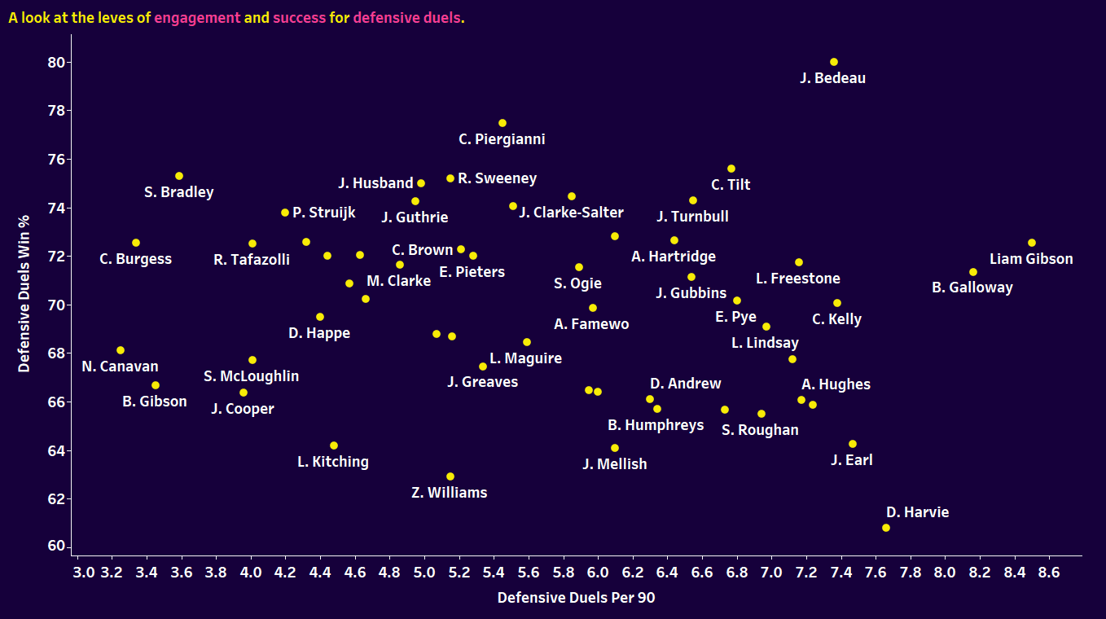
Digging a little deeper into these defenders’ defensive ability, we now explore their data for defensive duels, looking at their engagement and success levels.
Jacob Bedeau deserves another mention thanks to his high engagement (7.36 defensive duels per 90) combined with a strong success rate of 80%—this shows that he is confident enough to get stuck in with defensive duels consistently and also has the technical execution to come away as the victor more often than not.
Brendan Galloway and Harrogate Town’s Liam Gibson both have high engagement rates (8.16 and 8.5 defensive duels, respectively) and also post similar success rates – it may look like their success rates are nothing special in comparison to many of the other defenders in this analysis, but because they’re making more attempts, that success rate of around 72% is actually very impressive.
When looking at a defender with a more average engagement but with good success levels, Stevenage veteran Carl Piergianni ticks that box, making 5.45 attempts per 90, which is nothing to write home about.
Still, he boasts a remarkable 77.47% success rate.
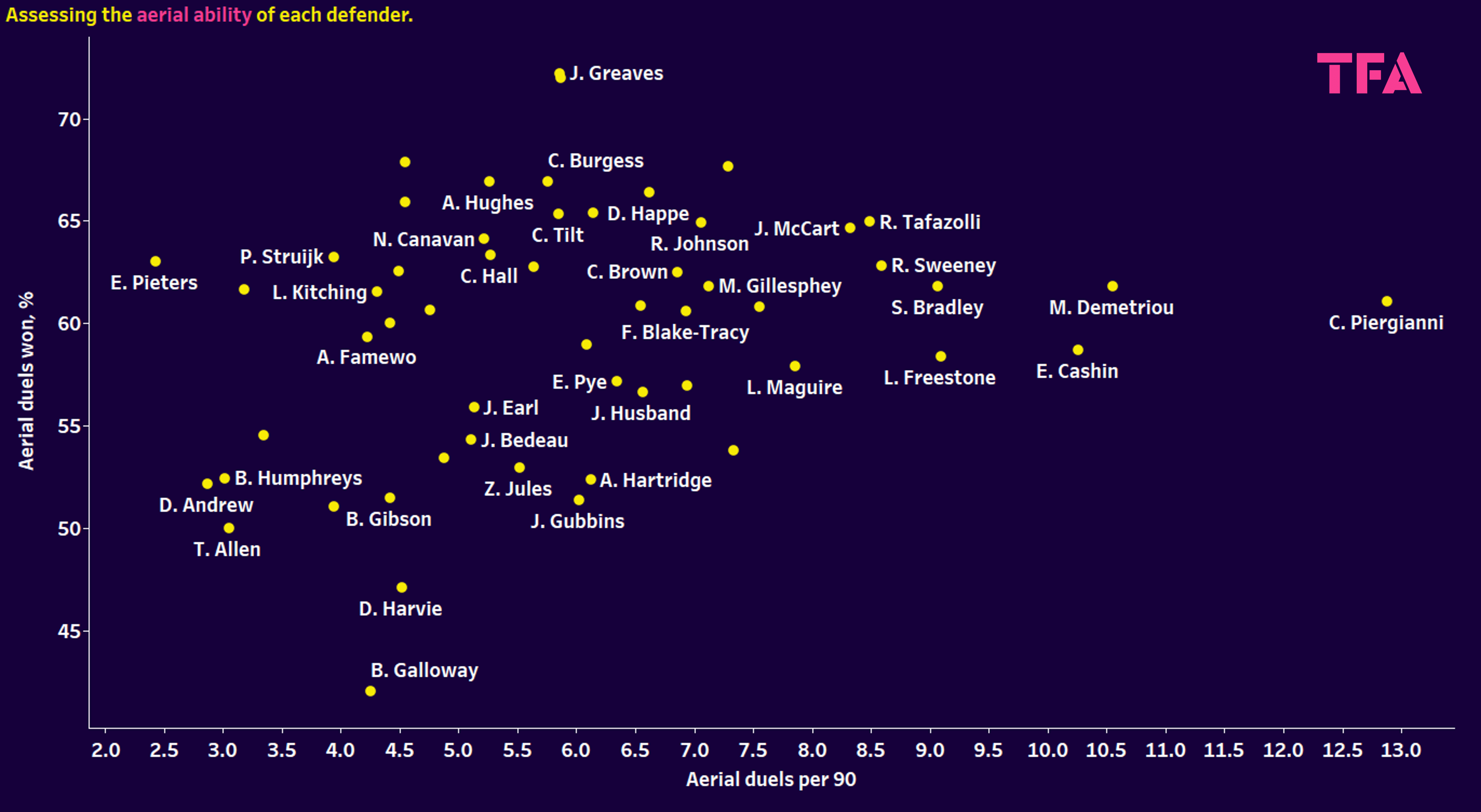
Winning headers and being effective in aerial duels is vital to being a central defender.
From battling in the air from goal-kicks to defending crosses aerially, it is a huge plus if a CB can dominate those aerial battles.
Ipswich Town’s Jacob Greaves, who played for Hull City last season, was highly effective in the air, winning 72.22% of his 5.86 aerial duels per 90 – Preston North End defender Liam Lindsey has posted almost identical numbers to Greaves, indicating that he too is a dominant aerial presence.
Piergianni is mentionable again thanks to his high engagement of 12.88 aerial duels per 90 – an exceptionally high attempt average; his success rate of 61.05% falls around the average mark in this data set, but that does mean he is winning 7.86 aerial duels per 90.
Passing Ability
It’s no secret that most managers want at least one of their central defenders to be effective on the ball – and a good passing range is a vital part of that.
From the Championship down to League Two, as well as in surrounding divisions, if a CB/LCB can consistently execute a variety of passes effectively, they could become a key player for their team and the manager’s tactics.
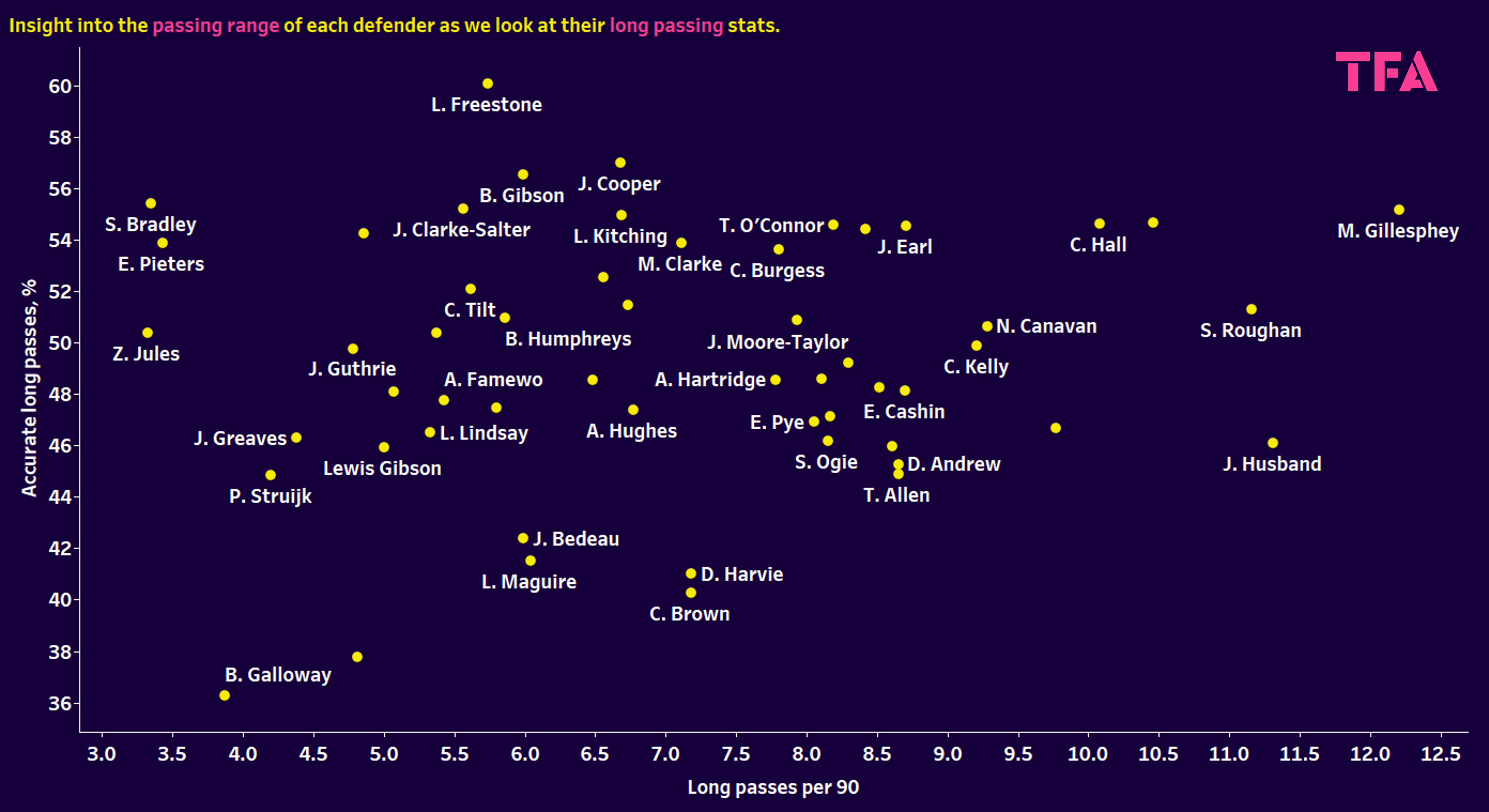
While we could’ve started this analysis segment by examining the number of total passes and total pass accuracy of these defenders, the aim is to establish which players are strong in passing range.
There are a few left-footed central defenders in the EFL who can execute long passes—Lewis Freestone has an impressive accuracy rate of 60.08%, Ben Gibson has an accuracy rate of 56.52%, and Jake Cooper has an accuracy rate of 56.99%.
These three players all have similar engagement rates that don’t register as high.
If we want a player with a high engagement rate and a good success rate, look no further than Charlton Athletic’s Macauley Gillesphey, who averages 12.21 long passes per 90 and brings a success rate of 55.17%: evidence of his impact when it comes to long passes, which, from the back, can be extremely effective in moving possession into dangerous areas.
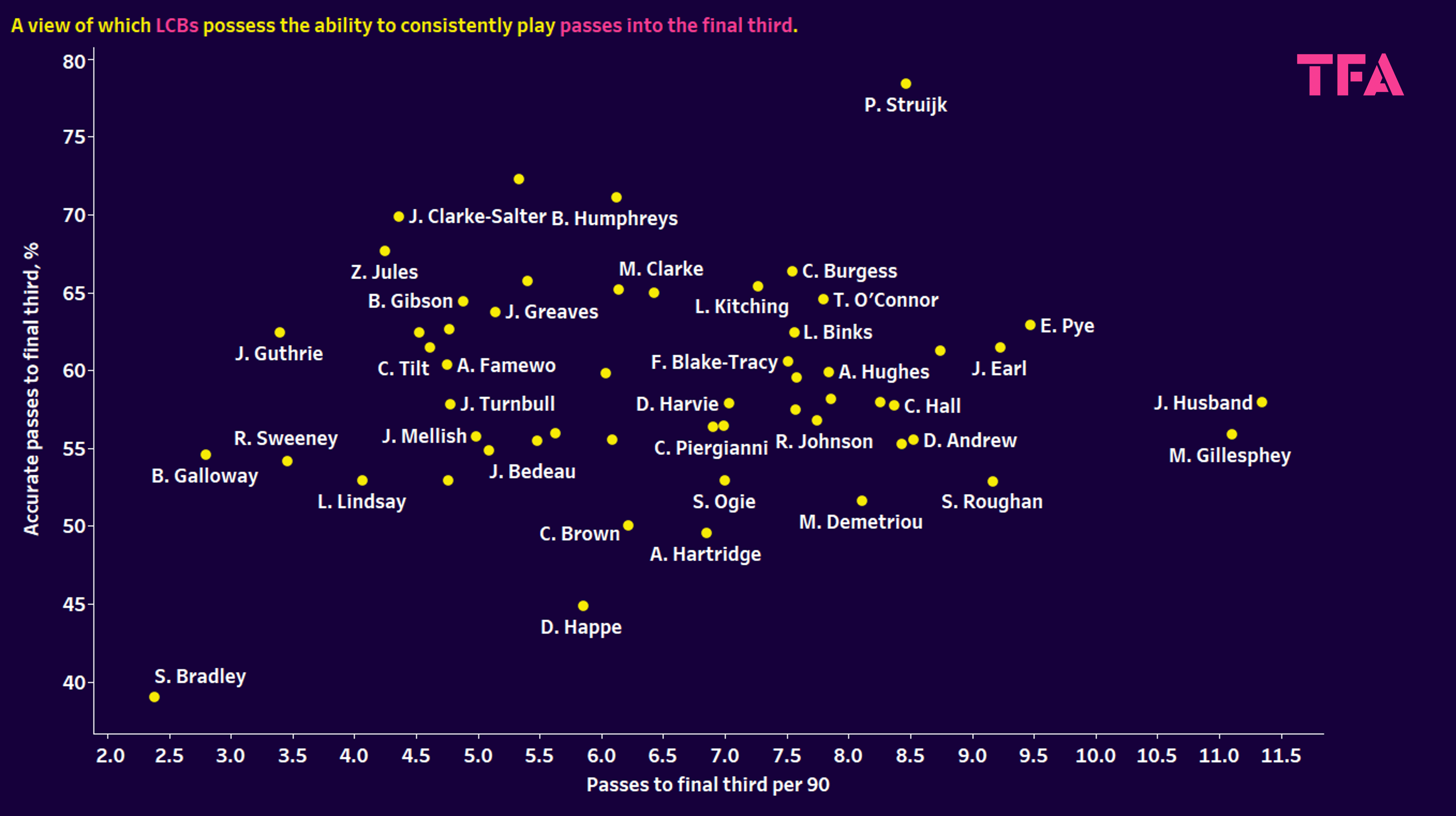
The long pass statistic does what it says on the tin but doesn’t indicate where those passes are going—that’s where the passes to the final third metric come in handy.
The ability to move the ball into the attacking third via a range of passes can indicate a defender with high technical ability.
Leeds United’s Pascal Struijk leads the way in this regard—he has a positive engagement level of 8.47 passes to the final third per 90 paired with an outstanding accuracy rate of 78.42%.
These numbers reflect Struijk’s in-possession ability and his role from a tactical perspective—he can sometimes be seen stepping into midfield areas to be involved in possession.
Other names show positive signs when it comes to passing to the final third, but according to the data, Struijk is the strongest in this area in the EFL.
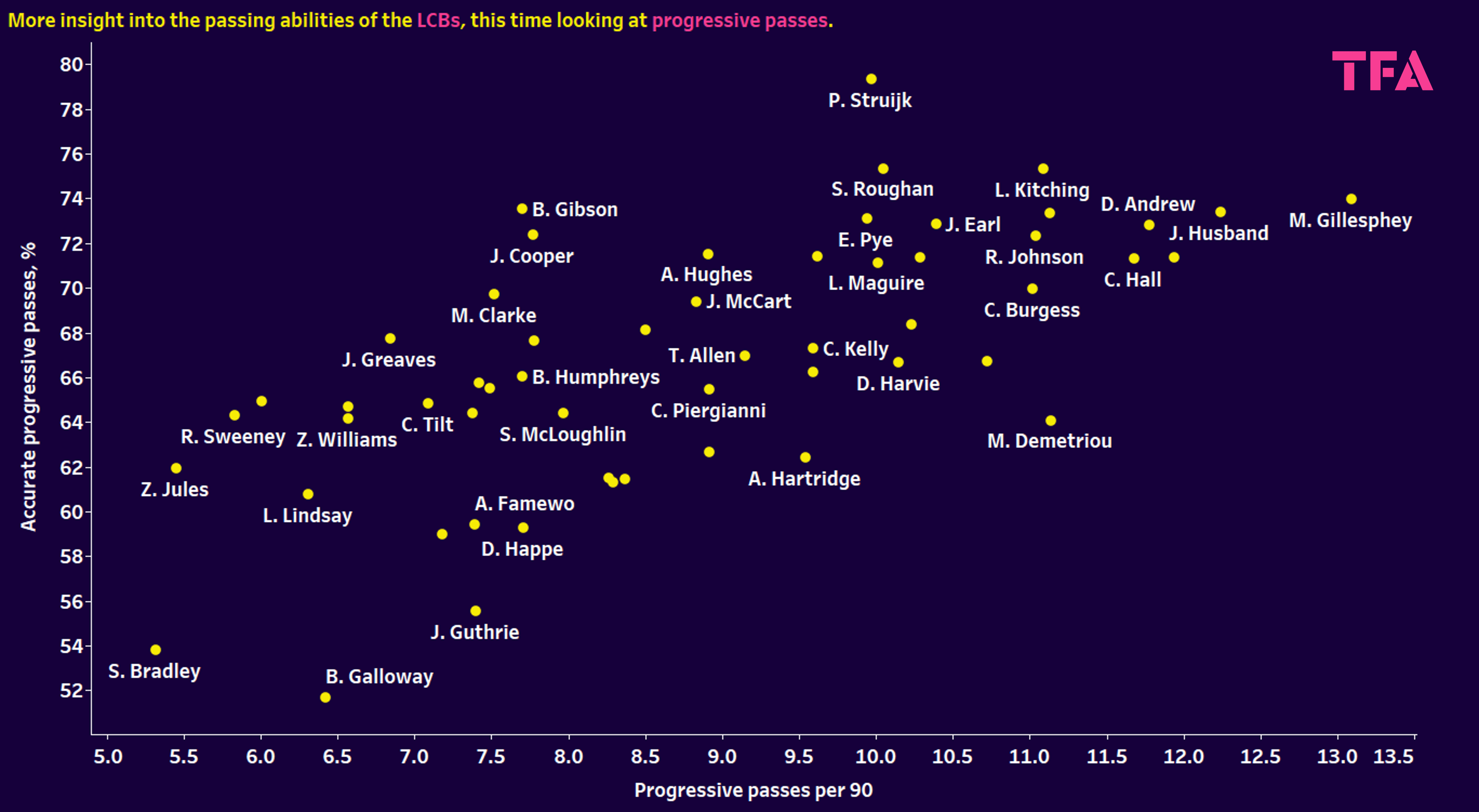
Progressive passes are an important tool in moving possession forward a significant distance.
CBs can get involved by playing passes that break lines during build-up play or springing their team into a counter-attack during transitions.
Struijk excels again, making a high number of progressive passes per 90, matched with a high accuracy rate.
Elsewhere, Gillesphey posts impressive numbers thanks to his strong accuracy rate and remarkably high engagement; James Husband posts similar numbers.
Coventry City defender Liam Kitching, who is in his second season at the club, posts a good engagement with progressive passes, making 11.09 per 90.
His accuracy rate of 75.31 tells us that Kitching is a top Championship asset when it comes to contributing to build-up phases.
At just 21 years of age, Lincoln City‘s Sean Roughan shows a lot of promise in possession, as his progressive pass data tells us – a slightly lower engagement than Kitching but an almost identical success rate, showing that he can be effective on the ball.
Attacking Contribution
Passing isn’t the only way a defender can contribute in possession.
These days, we see many central defenders who like to carry the ball out of defence into midfield—similar to Micky van de Ven for Tottenham Hotspur.
Additionally, goalscoring and creating goalscoring opportunities can be valuable traits for a defender.
Although these statistics do not necessarily judge them, they can be a great asset to the team by bringing this trait to the table.
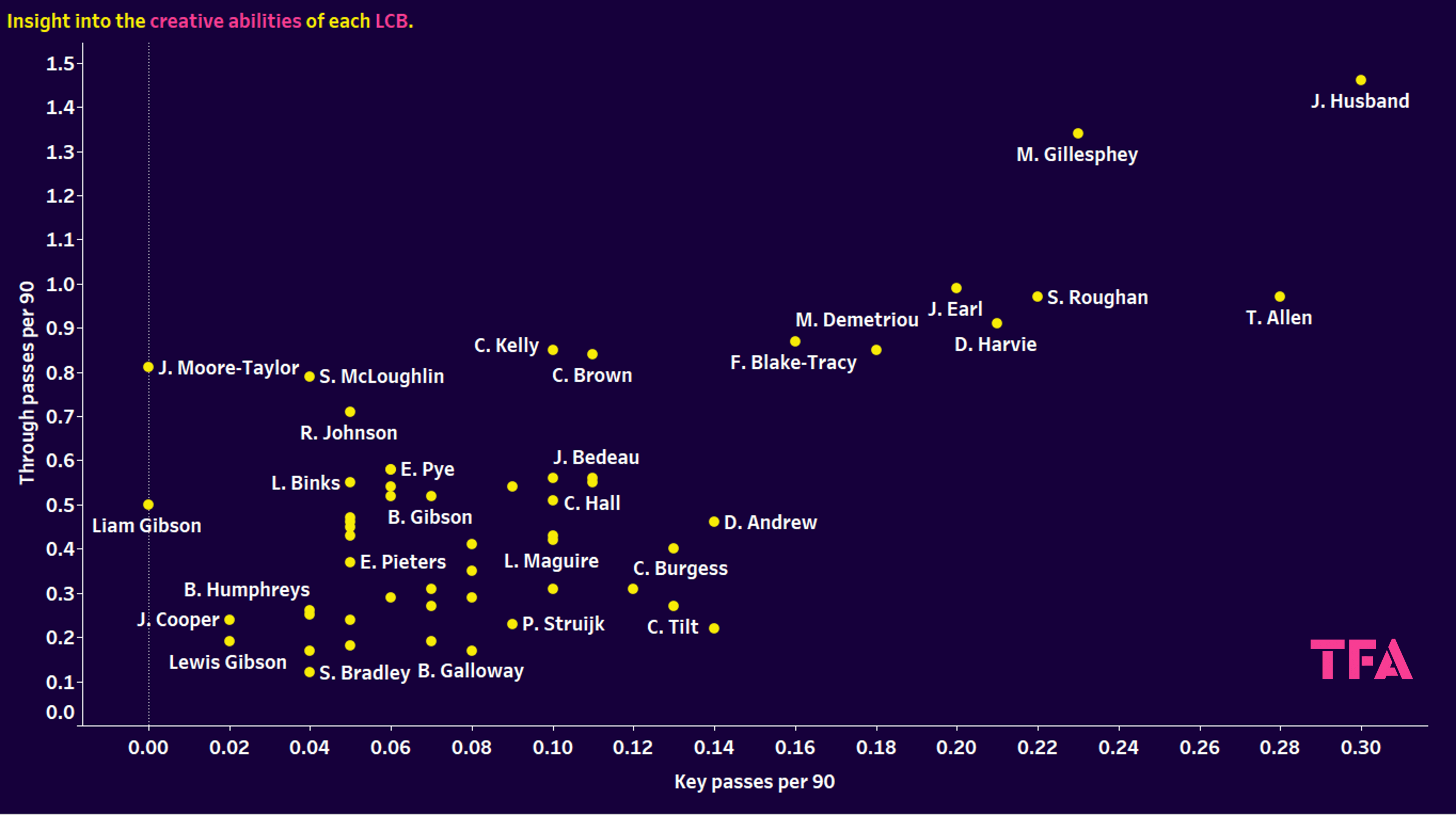
We start with a view of the creative output of the defenders.
While chance creation isn’t something central defenders are judged on, as mentioned, if they can provide such services, their stock will surely rise.
Former Doncaster Rovers man James Husband does well in this regard, making 0.3 key passes per 90.
He also attempts 1.46 through passes per 90 (29.73% accuracy), indicating that Husband has the ability to make things happen from deeper areas of the pitch.
Gillesphey’s name crops up again as he, too, is effective in making a good number of key passes (0.23 per 90) and 1.34 through passes per 90.
His accuracy with through passes is exceptional, too—42.86% of those passes reach their target, quite astounding for a CB.
Below those two, several names jump out for making waves in both metrics, including Roughan, Walsall’s Taylor Allen, and Barnsley’s Josh Earle, for example.
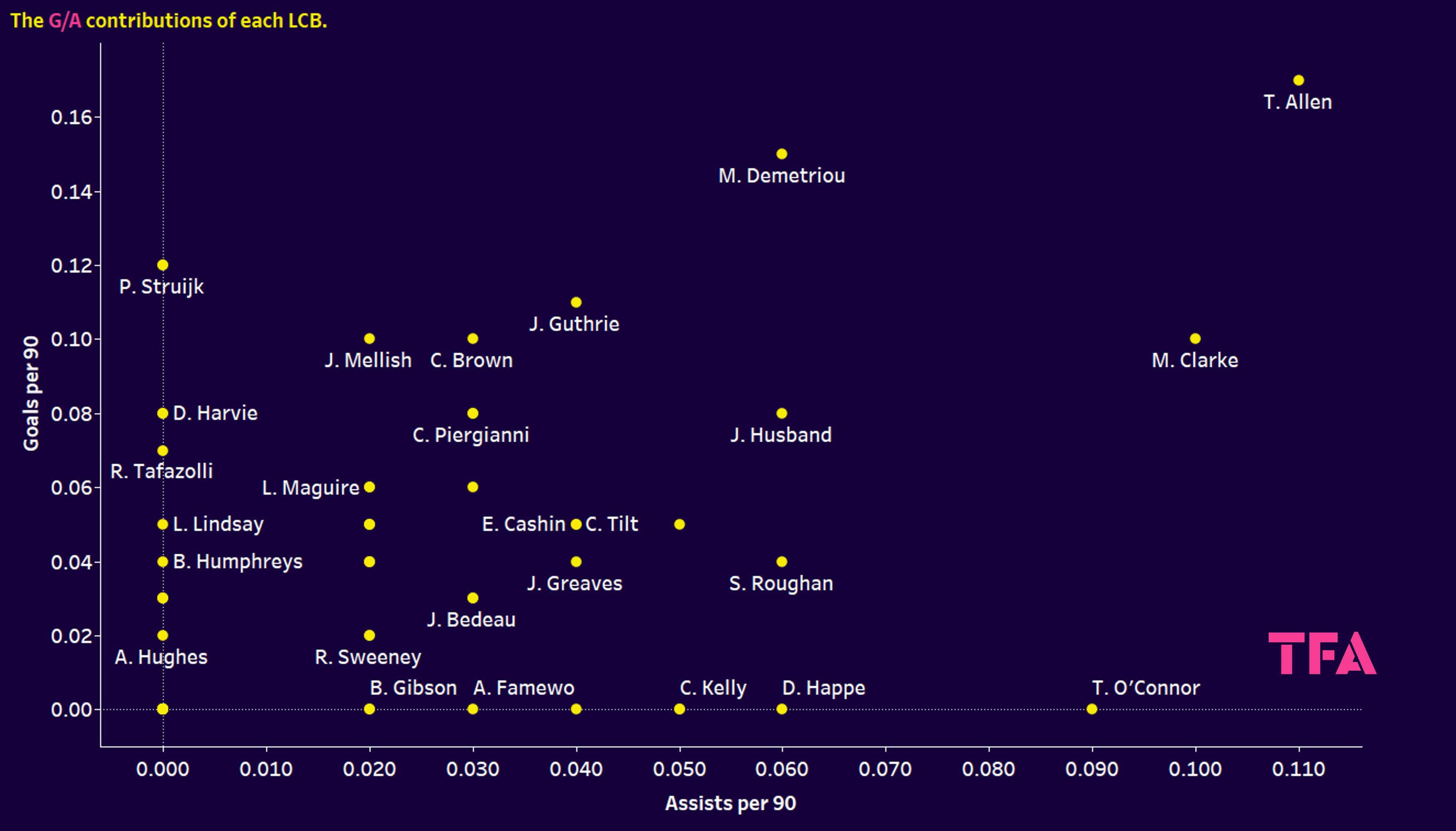
Goal-scoring and chance-creating defenders can be valuable assets; a few within the EFL offer such traits.
Taylor Allen leads the way in both areas.
He has provided four assists since the start of last season, equalling 0.11 per 90 minutes.
He is also a goal threat, scoring six goals, equalling 0.17 per 90 minutes.
The only defenders in this analysis who get close to Allen’s assist numbers are Middlesbrough’s Matthew Clarke and Wrexham’s Thomas O’Connor.
Meanwhile, Crewe fan favourite Mickey Demetriou and Leeds’ Struijk come closest to Allen’s goalscoring numbers – the former in particular, who, despite a lower goals per 90 rate of 0.15, has scored 10 goals since the start of last season.
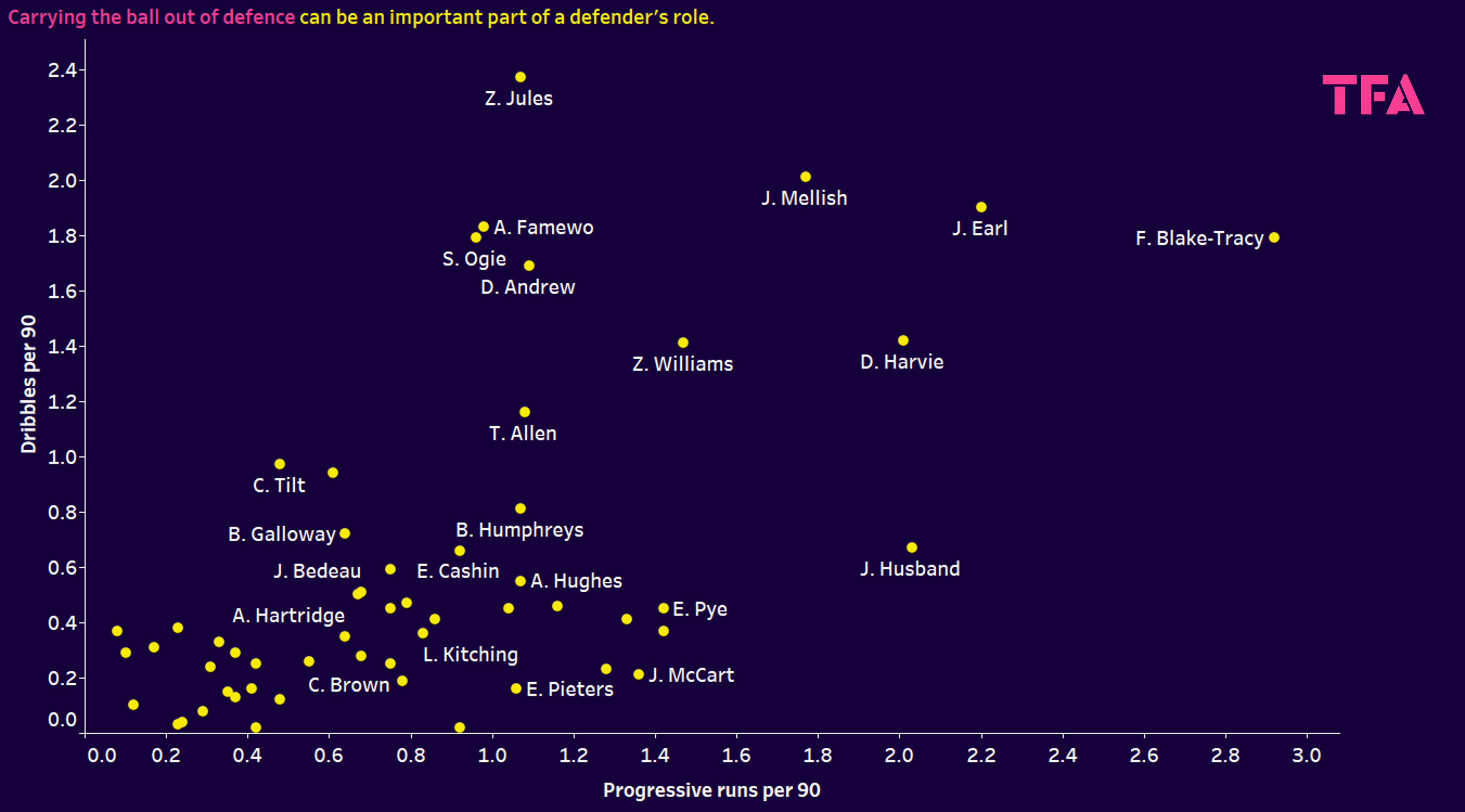
Carrying the ball out of defence or even carrying the ball over a short distance can be important and desirable traits for centre-backs.
This trait can depend on a team’s tactics—some teams do not want their CBs to dribble the ball too much, but often, in teams that play a fast-paced or possession-based game, central defenders are encouraged to progress into midfield if the chance arises.
Rotherham United’s Zak Jules offers a high number of dribbles—his pace and strength to protect the ball help him attempt 2.37 dribbles per 90 seconds.
Some of those, though, are short-burst runs with the ball.
If we want to identify players who carry the ball over larger distances, the progressive runs metric helps us with that—players like James Husband, Wycombe Wanderers’ Daniel Harvie, Josh Earl, and Mansfield Town’s Frazer Blake-Tracy offer such a trait.
Conclusion
This data analysis helped identify some of the top left-footed central defenders in the EFL (of course, some players missed out on selection due to match minutes).
When considering talents on the ball, Pascal Struijk is an established key player in possession.
We also saw impressive statistics from Macauley Gillesphey, James Husband, and Taylor Allen, among others.
Defensively, positive data came from players such as Carl Piergianni and Jacob Bedeau, showing an ability to be physically imposing in a defensive capacity.






Comments